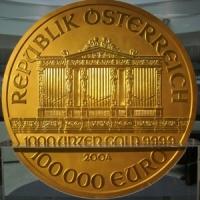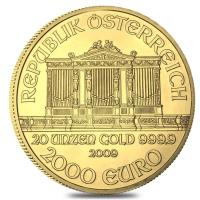Austrian Gold Philharmonic Coins

 Gold Philharmonics - Europe's best-selling gold coins
Gold Philharmonics - Europe's best-selling gold coins
The Austrian Gold Philharmonic coins are not only Europe's best-selling gold coins but were also the world's best-selling gold coins in certain years (1992, 1995, 1996, 2000). Up to 2012, more than 14 million Gold Philharmonics have been sold, weighing approximately 329 tons of gold. The popular 99.99% pure gold coins (24 karat) count among the purest in the gold coin market today. Made by the Austrian Mint since 1989, they are also known as the Vienna Philharmonic gold coins. That is because their name and design was chosen as a tribute to the world-renowned Vienna Philharmonic Orchestra (Wiener Philharmoniker).
The coins are commonly available as brilliant uncirculated or proof coins in the denominations of 1 oz, 1/2 oz, 1/4 oz, 1/10 oz and 1/25 oz. Fifteen giant Austrian Philharmonic gold coins of 1,000 oz as well as 6,027 large 20 oz coins were also once fabricated. Investors have the choice to buy Gold Philharmonic coins individually or in tubes of ten.
Investors who buy gold for their Individual Retirement Accounts (IRA's) may include Austrian Philharmonic coins. Even though their face value is in Euros, they are only legal tender in Austria and not in the entire eurozone. The Gold Philharmonic's weight and purity is guaranteed by the government of Austria.
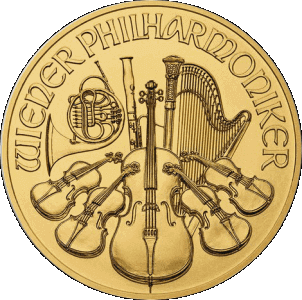
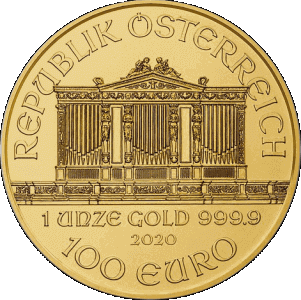
Coin Specifications
| Weight | Face Value | Purity | Diameter x Thickness |
|---|---|---|---|
| 1 oz | 100 Euro | 99.99% | 37 x 2 mm |
| 1/2 oz | 50 Euro | 99.99% | 28 x 1.6 mm |
| 1/4 oz | 25 Euro | 99.99% | 22 x 1.2 mm |
| 1/10 oz | 10 Euro | 99.99% | 16 x 1.2 mm |
| 1/25 oz | 4 Euro | 99.99% | 13 x 0.92 mm |
Gold Philharmonic Coin Design
The design of the Austrian Gold Philharmonic coin was created by the chief engraver of the Austrian Mint, Thomas Pesendorfer. It has remained unchanged ever since 1989. The obverse side displays an image of classical music instruments of the Vienna Philharmonic Orchestra, including a horn, harp, cello and four violins. The German name "Wiener Philharmoniker" of the Vienna Philharmonic Orchestra is engraved along the coin's edge.
The reverse side features the Great Organ that is located in the Viennese Concert Hall, the home venue of the Vienna Philharmonic Orchestra. The words "Republik Österreich" (Austrian Republic) are engraved above the organ and the coin's date of mintage, face value as well as actual gold weight and purity appear below. The coins that are also known as the Vienna Philharmonic gold coins have a reeded edge.
History of the Gold Philharmonic Coins
The Austrian Mint in Vienna started minting the 1 oz and 1/4 oz Gold Philharmonic coin in the year 1989. The 1/10 oz and 1/2 oz coins were added to the series in 1991 and 1994 respectively. The 1/25 oz coin is the newest addition to the popular coin series with its first issuance in 2014.
The coins quickly became popular with Europeans that are investing in gold. Already in 1990, the Austrian Gold Philharmonics were Europe's best selling coins. According to the World Gold Council, they were the world's best-selling gold coins in 1992, 1995, 1996 and 2000. Until 2001, the coins were issued in denominations of Austrian Schilling. Since 2002, they are minted as Euros. More than 14 million specimens of the Austrian Gold Philharmonic were sold worldwide between 1989 and 2012.
For the coin's 20th anniversary in 2009, the Austrian Mint produced 6,027 coins of 20 oz with a face value of 2,000 Euros each.
Furthermore, the Austrian Mint produced 15 special 1,000 oz versions of the Austrian Philharmonic gold coin for the 15th anniversary of the coin's existence in 2004. They are known as "Big Phil" and have a face value of 100,000 Euros each. Each of these coins required 130 hours to produce. The 15 coins were all sold within two weeks after sales began.
Mintage Numbers
The first 1 oz Vienna Philharmonic gold coin was minted in 1989. Annual mintages vary between 54,700 coins in 2001 up to 903,047 coins in 2009. The 1/2 oz gold bullion coin was first produced in 1994. The years with the lowest annual mintage were 2000 (20,500 coins), 2005 (21,049 coins) and 2006 (20,085 coins). The lowest annual mintages of the 1/4 oz coin (produced since 1989) were 25,800 coins in 2001 and 25,900 coins in 2000. The 1/10 oz coin that is issued since 1991 had its lowest annual production in 2001 with 26,400 coins. Production of the 1/25 oz coin just started in 2014 with 78,551 coins.
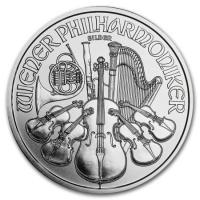
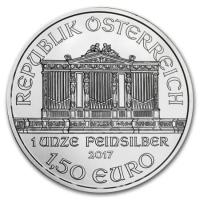
Austrian Silver Philharmonics
The Austrian Mint introduced the 1 oz Silver Philharmonics in 2008. The coins are struck out of 99.9% pure silver and have a face value of 1.50 Euros. Their diameter is identical to the Gold Philharmonic coins but they are a little thicker (3.2 mm). The design of the Austrian Silver Philharmonic coins is also identical to that of the gold coins. The silver coins have a smooth edge though. More than 54 million pieces of this silver bullion coin were sold between 2008 and 2012. The coins are sometimes also referred to as the Vienna Philharmonic silver coins because their name and design was chosen as a tribute to the world-renowned Vienna Philharmonic Orchestra.
The Austrian Silver Philharmonic page gives more information about the coins and allows you to compare current prices.
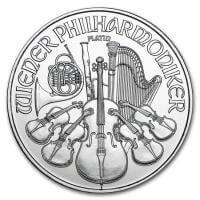
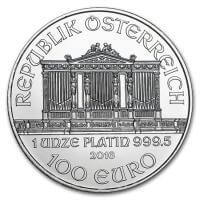
Austrian Platinum Philharmonics
The Austrian Mint started issuing Platinum Philharmonic coins in 2016. Only 1 oz coins were minted that inaugural year. The coins with a face value of 100 Euros are identical in size (37 mm diameter) to the gold and silver 1 oz coins. Fractional 1/25 oz coins are minted since 2017. Both coin denominations are only available with a brilliant uncirculated finish. The coins out of 99.95% pure platinum are identical in design to the gold and silver versions of the Philharmonic coins. The name and design of the Austrian Platinum Philharmonics was chosen as a tribute to the world-famous Vienna Philharmonic Orchestra. The obverse side of the coins shows an arrangement of classical music instruments and the Great Organ that is located in the Viennese Concert Hall appears on the reverse.
The Austrian Platinum Philharmonic page gives more information about the coins and allows you to compare current prices.
Austrian Philharmonic Gold Coin Sets
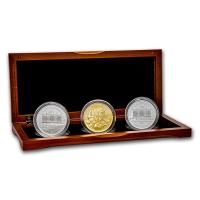
3x1 oz Philharmonic Set 2016
total gold weight: 1 oz
total silver weight: 1 oz
total platinum weight: 1 oz
The set consists of all three 1 oz Austrian Philharmonic coins. Whereas the 1 oz gold (since 1989) and silver coins (since 2008) already existed for years, the platinum coin was minted for the first time in 2016.
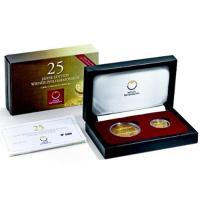
2 Coin Gold Philharmonics Proof Set 2014
total gold weight: 1.25 oz
This set commemorates the 25th anniversary of the popular Austrian Philharmonic gold coins. It includes the proof 1 oz and 1/4 oz Gold Philharmonic coin from 2014. The sets include a certificate of authenticity and are contained in a wooden collector box. Only 5,000 such sets will ever be issued.
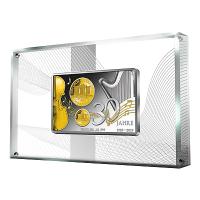
30th Anniversary Set 2019
total gold weight: 1.25 oz
total silver weight: 6.53 oz
As a way to commemorate the 30th anniversary of the Austrian Gold Philharmonic coins, the Austrian Mint released this unique 2 coin set in 2019. It includes the brilliant uncirculated 1 oz and 1/4 oz Gold Philharmonics from 1989, the first year of mintage. The two coins are enclosed within a 99.9% pure silver bar that has some selective gold plating to enhance its design. The set comes issued in a box with a certificate of authenticity.
